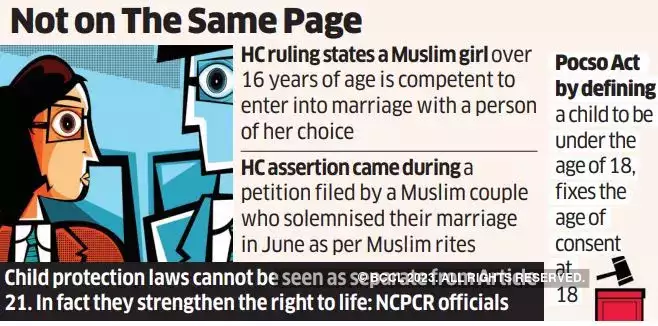
MARRIAGE ACT FOR MINORS
MARRIAGE ACT FOR MINORS
Main Examination: General Studies Paper-1
Reference:
- Recently, the Assam Government has announced that men marrying minor girls will be booked under stringent laws ranging from two years to life imprisonment.
- The Supreme Court will examine whether minor girls can marry on the basis of customary social practices or personal laws, while such marriages are considered offenses under the Prohibition of Child Marriage Act (PCMA), 2006.
Current Status of Marriage Law in India:
- The legal age of marriage for men and women is 18 and 21 years respectively and early marriage comes under the prohibited practice of child marriage. However, it is not uniform across different communities.
- Under Muslim personal law in India, people who have attained puberty, i.e. on attaining the age of 15, are eligible to marry while they are still minors.
- Under Hindu Marriage Act-1955, Parsi Marriage and Divorce Act-1936, Special Marriage Act-1954 and Indian Christian Marriage Act-1872, the minimum age of marriage for a man is 21 years and for a woman is 18 years.
- Child marriage is prohibited in India as per the Prohibition of Child Marriage Act (PCMA), 2006. Marriage below the prescribed age is illegal and forced child marriages can be punished.
- The PCMA does not have any provision that says that the PCMA law will override any other law on the issue, thus establishing an anomaly between the Prohibition of Child Marriage Act and the Muslim Personal Law on the minimum age of marriage.
Demand For Change in Legal Age
- The National Commission for Protection of Child Rights (NCPCR) filed a petition against a recent order of the Punjab and Haryana High Court.
- A June 2022 Punjab and Haryana High Court order states that notwithstanding the provisions of the POCSO Act, 2012, a girl child who has attained the age of 15 years or more can be married on the basis of Muslim personal law.
Arguments given by the High Court:
- The High Court said that the Special Marriage Act does not override personal laws, Muslim personal law will prevail.
- The Supreme Court said that the order of the High Court will not serve as a judicial precedent for other courts.
- The National Commission for Women has filed a petition in the Supreme Court to make the minimum age of marriage for Muslim women at par with that of persons of other religions.
- The Prohibition of Child Marriage (Amendment) Bill, 2021 seeks to amend the Prohibition of Child Marriage Act (PCMA), 2006 to raise the minimum age of marriage for women from 18 to 21 years.
- The Supreme Court has appealed to Parliament to lower the age of consent under the POCSO Act and the IPC, which has fixed it at 18 years, thus criminalizing consensual sexual activity by all juveniles.
- Many cases of sexual assault under POCSO and other laws relating to 16-18 year olds in the country are registered with consent and reported by a girl's family who disapprove of the juvenile's conduct.
States with the highest number of child marriages:
There are 70 districts spread over 13 states including Assam, Bihar, Gujarat, Jharkhand, Karnataka, Madhya Pradesh, Maharashtra, Rajasthan, Uttar Pradesh and West Bengal where the prevalence of child marriage is high.
According to the National Family Health Survey-5 report (NFHS-5), on an average 31.8% of girls in Assam are married before the age limit and 11.7% become mothers before adulthood. The national average is 23.3% and 6.8% respectively.
Negative impacts of child marriage:
- Premature birth can lead to poor maternal and child health and poor nutritional status. As per NFHS-5, 59% of Indian girls in the 15-19 age group suffer from anaemia.
- Women with 10 or more years of schooling in NFHS-5 is 41% of the national average. Women who complete their schooling often decide to raise children with better care and nutrition.
- Due to higher fertility, minor girls are more likely to have large families compared to the replacement rate of 2.1.
- Appropriate skill set may not be acquired due to early responsibility of managing the household, leading to poverty and poor family planning.
- According to the Young Lives, India-NCPCR study, due to the patriarchal mindset of the family members, women exercise less decision-making rights in family matters.
Conclusion:
- In the context of family law reform, in 2008, the Law Commission suggested an age of 18 for boys and girls to marry. The Law Commission believed that when a citizen can vote at 18, he should also be allowed to marry at the age of 18.
- The legal marriageable age of a woman should be based on the structure of a society that provides her ideal development in the field of education, a skill set to enhance her employability and enhances her decision making power.
--------------------------------------------------------------
Main Exam Question-
Mention the laws related to child marriage in India. Suggest measures to prevent child marriage.